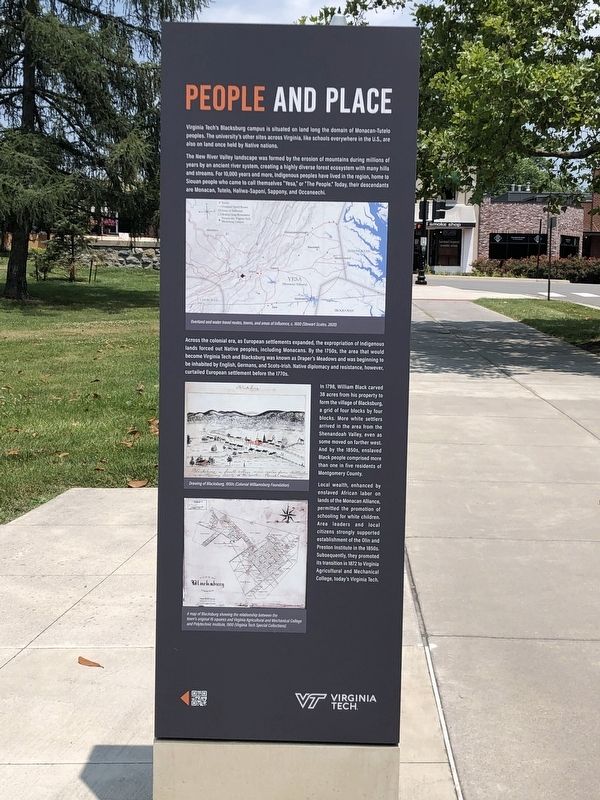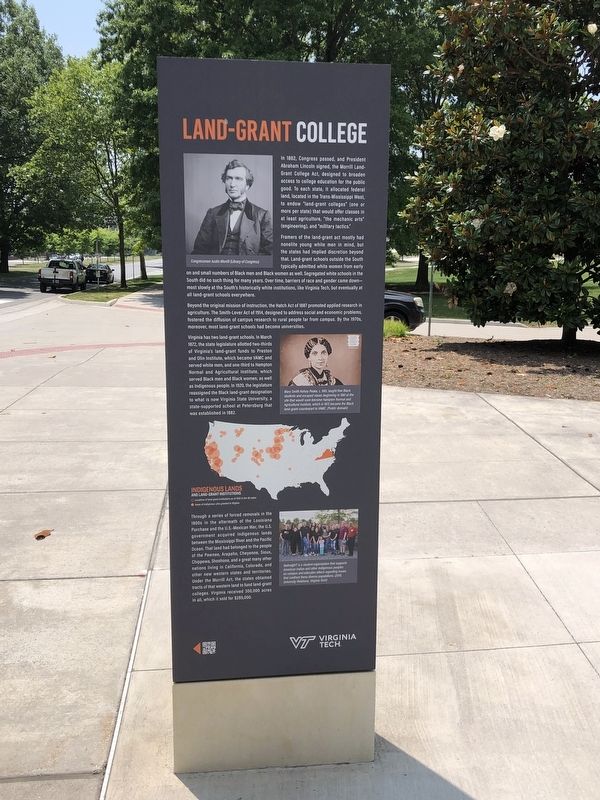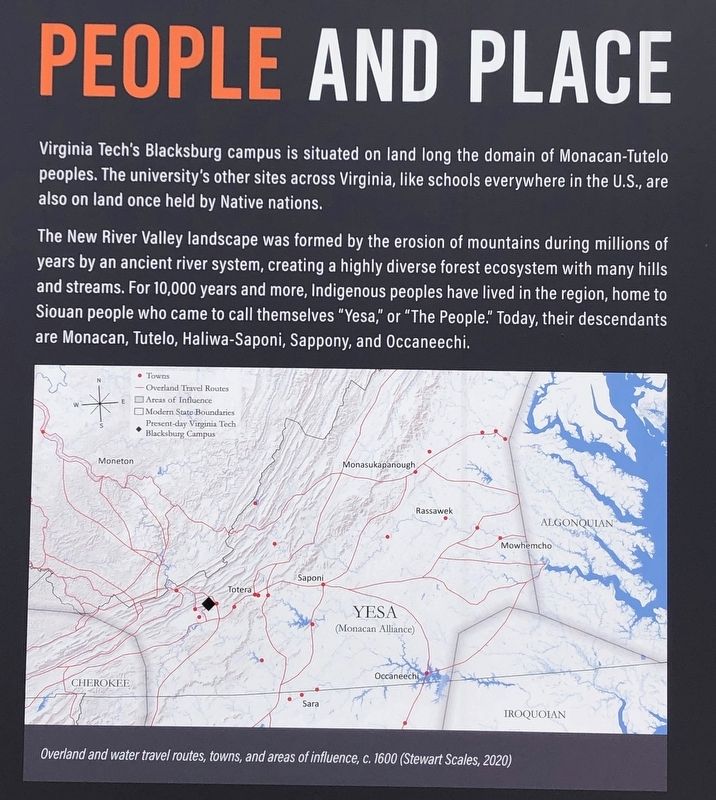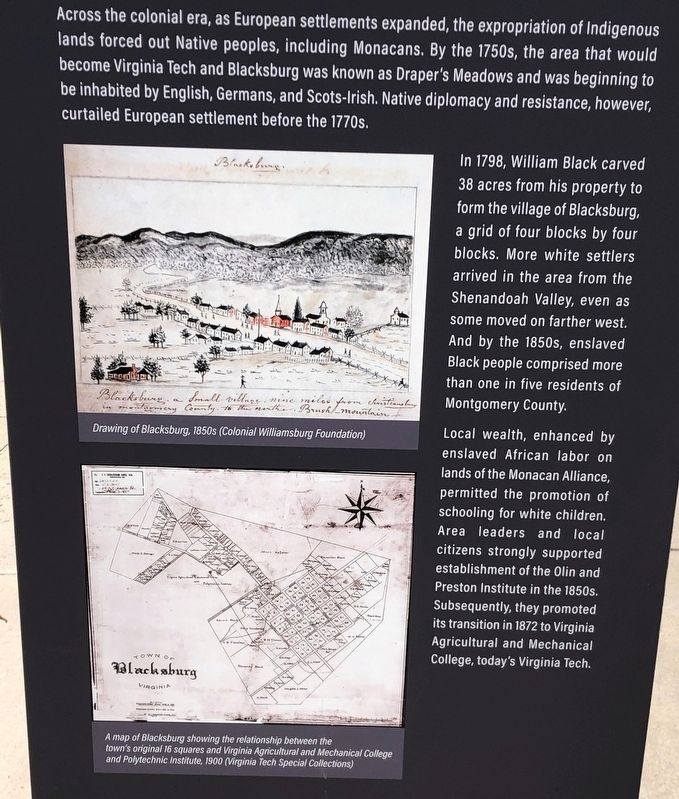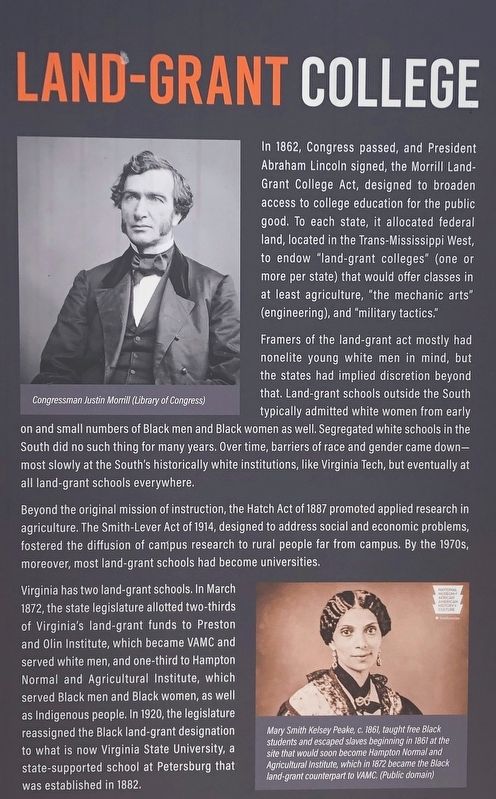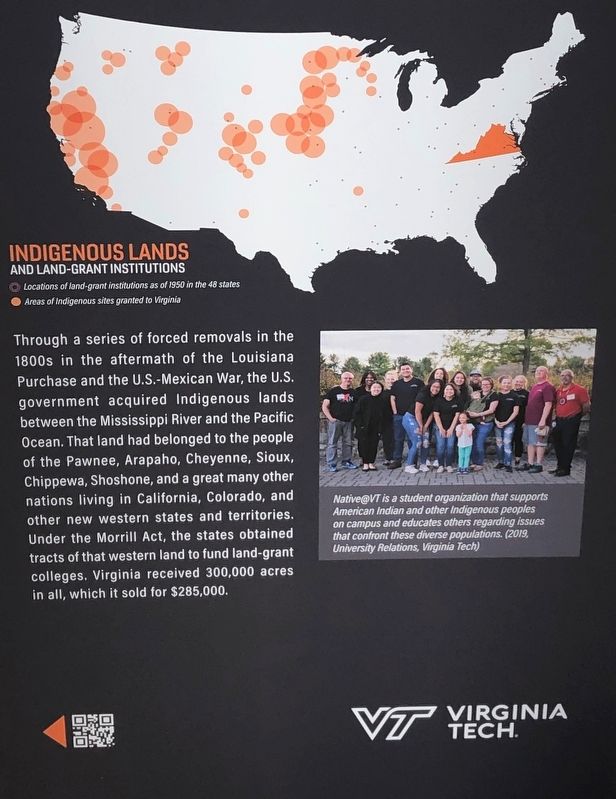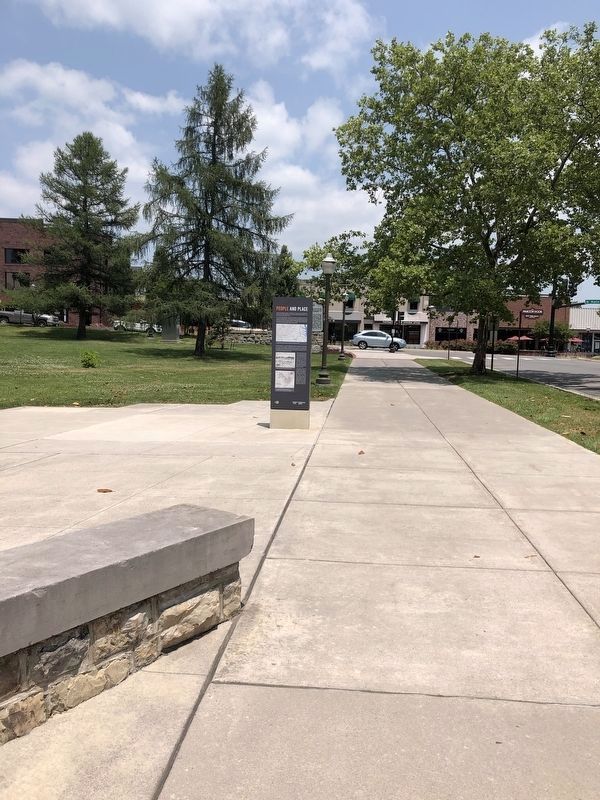University in Blacksburg in Montgomery County, Virginia — The American South (Mid-Atlantic)
People and Place / Land Grant College
The New River Valley landscape was formed by the erosion of mountains during millions of years by an ancient river system, creating a highly diverse forest ecosystem with many hills and streams. For 10,000 years and more, Indigenous peoples have lived in the region, home to Siouan people who came to call themselves “Yesa” or “The People.” Today, their descendants are Monacan, Tutelo, Haliwa-Saponi, Sappony, and Occaneechi.
Across the colonial era, as European settlements expanded, the expropriation of Indigenous lands forced out Native peoples, including Monacans. By the 1750s, the area that would become Virginia Tech and Blacksburg was known as Draper's Meadows and was beginning to be inhabited by English, Germans, and Scots-Irish. Native diplomacy and resistance, however, curtailed European settlement before the 1770s.
In 1798, William Black carved 38 acres from his property to form the village of Blacksburg, a grid of four blocks by four blocks. More white settlers arrived in the area from the Shenandoah Valley, even as some moved on farther west. And by the 1850s, enslaved Black people comprised more than one in five residents of Montgomery County.
Local wealth, enhanced by enslaved African labor on lands of the Monacan Alliance, permitted the promotion of schooling for white children. Area leaders and local citizens strongly supported establishment of the Olin and Preston Institute in the 1850s. Subsequently, they promoted its transition in 1872 to Virginia Agricultural and Mechanical College, today's Virginia Tech.
[Captions (top to bottom)]
• Overland and water travel routes, towns, and areas of influence, c. 1600 (Stewart Scales, 2020)
• Drawing of Blacksburg, 1850s (Colonial Williamsburg Foundation)
• A map of Blacksburg showing the relationship between the town's original 16 squares and Virginia Agricultural and Mechanical College and Polytechnic Institute, 1900 (Virginia Tech Special Collections)
Land Grant College – In 1862, Congress passed, and President Lincoln signed, the Morrill Land-Grant College Act, designed to broaden access to college education for the public good. To each state, it allocated federal land, located in the Trans-Mississippi West, to endow “land-grant colleges” (one or more per state) that would offer classes in at least agriculture, “the mechanic arts” (engineering) and “military tactics.”
Framers of the land-grant act mostly had nonelite young white men in mind, but the states had implied discretion beyond that. Land-grant schools outside the South typically admitted white women from early on and small numbers of Black men and Black women as well. Segregated white schools in the South did no such thing for many years. Over time, barriers of race and gender came down – most slowly at the South's historically white institutions, like Virginia Tech, but eventually at all land-grant schools everywhere.
Beyond the original mission of instruction, the Hatch Act of 1887 promoted applied research in agriculture. The Smith-Lever Act of 1914, designed to address social and economic problems, fostered the diffusion of campus research to rural people far from campus. By the 1970s, moreover, most land-grant schools had become universities.
Virginia has two land-grant schools. In March 1872, the state legislature allotted two-thirds of Virginia's land-grant funds to Preston and Olin Institute, which became VAMC and served white men, and one-third to Hampton Normal and Agricultural Institute, which served Black men and Black women, as well as Indigenous people. In 1920, the legislature reassigned the Black land-grant designation to what is now Virginia State University, a state-supported school at Petersburg that was established in 1882.
Through a series of forced removals in the 1800s in the aftermath of the Louisiana Purchase and the U.S.-Mexican War, the U.S. government acquired Indigenous lands between the Mississippi River and the Pacific Ocean. That land had belonged to the people of the Pawnee, Arapaho, Cheyenne, Sioux, Chippewa, Shoshone, and a great many other nations living in California, Colorado, and other new western states and territories. Under the Morrill Act, the states obtained tracts of that western land to fund land-grant colleges. Virginia received 300,000 acres in all, which it sold for $285,000.
[Captions (top to bottom)]
• Congressman Justin Morrill (Library of Congress)
• Mary Smith Kelsey Peake, c. 1861, taught free Black students and escaped slaves beginning in 1861 at the site that would soon become Hampton Normal and Agricultural Institute, which in 1872 became the Black land-grant counterpart to VAMC. (Public Domain)
• Native@VT is a student organization that supports American Indian and other Indigenous peoples on campus and educates others regarding issues that confront these diverse populations. (2019, University Relations, Virginia Tech)
Erected by Virginia Tech University.
Topics. This historical marker is listed in these topic lists: African Americans • Education • Native Americans. A significant historical year for this entry is 1798.
Location. 37° 13.887′ N, 80° 24.998′ W. Marker is in Blacksburg, Virginia, in Montgomery County. It is in University. Marker is on Alumni Mall (Business U.S. 460) west of North Main Street, on the right when traveling west. Touch for map. Marker is at or near this postal address: 128 Alumni Mall, Blacksburg VA 24061, United States of America. Touch for directions.
Other nearby markers. At least 8 other markers are within walking distance of this marker. Virginia Polytechnic Institute and State University (here, next to this marker); The Early Years / Campus Over Time (within shouting distance of this marker); William Frank Henderson (about 500 feet away, measured in a direct line); The Cellar Building (about 500 feet away); William Black (about 700 feet away); John Houston Squires (approx. 0.2 miles away); The Armory (approx. 0.2 miles away); William Addison Caldwell (approx. ¼ mile away). Touch for a list and map of all markers in Blacksburg.
Credits. This page was last revised on July 16, 2023. It was originally submitted on July 12, 2023, by Duane and Tracy Marsteller of Murfreesboro, Tennessee. This page has been viewed 76 times since then and 17 times this year. Photos: 1, 2. submitted on July 12, 2023, by Duane and Tracy Marsteller of Murfreesboro, Tennessee. 3, 4, 5, 6, 7. submitted on July 13, 2023, by Duane and Tracy Marsteller of Murfreesboro, Tennessee.
